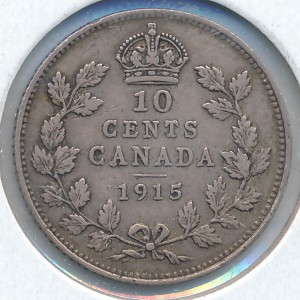by Michael Joffre
 Numismatics, the study of coins, allows us a mental “time machine” to travel to another era, and examine it through its money.
Numismatics, the study of coins, allows us a mental “time machine” to travel to another era, and examine it through its money.
Let’s visit Canada in 1915 when Robert Borden, the man on our current $100 bill, was Prime Minister. George V was King of England, and his image appeared on virtually all coins of the empire. Europe was in the middle of World War One. Montreal was the biggest city in Canada with almost half a million people. Bread was 6 cents a loaf, and eggs were about 34 cents a dozen.
Transactions were in cash, and cash was, for the most part, silver coins. With the war draining resources, the price of silver rose worldwide, and coins became more expensive to produce. This would explain the low mintages of Canadian coins in 1915.
 Denominations produced included the large copper cent, and the silver 5-, 10-, and 25- cent coins. For the first time in many years, no 50-cent coin (Canada’s largest silver coin at the time) was made. Also absent was the gold sovereign, and the $5 and $10 gold pieces, all of which had become quite popular before the war.
Denominations produced included the large copper cent, and the silver 5-, 10-, and 25- cent coins. For the first time in many years, no 50-cent coin (Canada’s largest silver coin at the time) was made. Also absent was the gold sovereign, and the $5 and $10 gold pieces, all of which had become quite popular before the war.
For collectors, finding 1915 dated 5-, 10-, and 25-cent pieces in new condition is a formidable challenge. Hardly any were saved new, and they now trade for thousands of dollars each. Easier to locate would be the same coins but in circulated (worn) condition, which are much more affordable, but still sell for a premium compared to ones for other dates of this era.
Michael Joffre is President of Carsley Whetstone & Company Inc., and is also a passionate collector and numismatic researcher. carsleys.com

Be the first to comment on "Coins are like a time machine"